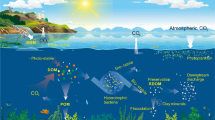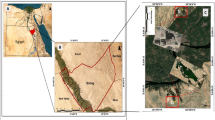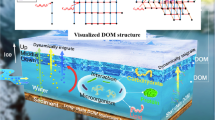Abstract
Wetlands across the Canadian prairies are typically shallow (<1.0 m) and exhibit high dissolved organic carbon (DOC) concentrations (>10 mg l−1). Studies have shown that DOC in such shallow wetlands is not as reliable an indicator of ultraviolet radiation (UVR) attenuation as it is in clearwater. Changes in DOC character and composition as a result of sunlight exposure might provide a reasonable explanation for this observation. To test this, we investigated seasonal changes in DOC optical and chemical properties in a shallow prairie wetland over a 2-year period. Although DOC concentration increased at least two-fold from spring until fall, DOC specific absorption (at 350 nm) and fluorescence decreased by 30 and 32%, respectively, for the same period. In both years, seasonal decreases in DOC molecular weight and size (from measurements of tangential filtration and mass electrospray mass spectrometry) were reflected in concomitant increases in spectral slope. 13C NMR analysis of DOC isolated on XAD-8 resins revealed a 49% decrease in aromatic moieties when spring values were compared to those in the fall. As well, δ13C signatures of this isolated DOC became heavier seasonally. In a short term photodegradation experiment (6 days) we noted a 47% decline in DOC specific absorption coefficients at 350 nm and a 15% increase in spectral slope when water exposed to the total light spectrum was compared to that of a dark control. Taken together, all of these observations were consistent with the occurrence of seasonal DOC photodegradation in shallow prairie wetlands and underlined the importance of this process in shaping DOC character and composition in these hydrologically dynamic systems. Our data also indicates that constant mixing and shallow depths in these wetlands were factors which enhanced DOC photodegradation. Although the high DOC concentrations of prairie wetlands should theoretically offer protection for their biota, seasonal photodegradation of DOC means that these systems may not be as protected as their high DOC concentrations suggest.
Similar content being viewed by others
References
Anesio A.M., Denward C.M.T., Tranvik L.J. and Graneli W. 1999. Decreased bacterial growth on vascular plant detritus due to photochemical modification. Aquat. Microb. Ecol. 17: 159–165.
Arts M.A., Robarts R.D., Kasai F., Waiser M.J., Tumber V., Plante A.L., Rai H. and de Lange H.J. 2000. The attenuation of ultraviolet radiation in high dissolved organic carbon waters of wetlands and lakes on the northern Great Plains. Limnol. Oceanogr. 45: 292–299.
Batt B.D., Anderson M.G., Anderson C.D. and Caswell F.D. 1989. The use of prairie potholes by North American ducks. In: van der Walk A.G. (Ed) Northern Prairie Wetlands. Iowa State University Press, Ames, pp. 204–227.
Benner R., Fogel M.L., Sprague E.K. and Hodson R.E. 1987. Depletion of 13C in lignin and its implications for stable carbon isotope studies. Nature 329: 708–710.
Bertilsson S. and Tranvik L.J. 2000. Photochemical transformation of dissolved organic matter in lakes. Limnol. Oceanogr. 45: 753–762.
Chen Y., Khan U. and Schnitzer M. 1978. Ultraviolet radiation of dilute fulvic acid solutions. Soil Sci. Amer. J. 42: 292–296.
Chin Y.-P., Traina S.J., Swank C.R. and Backhus D. 1998. Abundance and properties of dissolved organic matter in pore waters of a freshwater wetland. Limnol. Oceanogr. 43: 1287–1296.
Clair T.A. and Sayer B.G. 1997. Environmental variability in the reactivity of freshwater dissolved organic carbon to UV-B. Biogeochemistry 36: 89–97.
Curtis P.J. 1998. Climatic and hydrologic control of DOM concentration and quality in lakes. In: Hessen D.O. and Tranvik L.J. (eds) Aquatic Humic Substances: Ecology and Biogeochemistry. Springer, Berlin, pp. 93–105.
Curtis P.J. and Adams H.E. 1995. Dissolved organic matter quantity and quality from freshwater and saltwater lakes in Alberta. Biogeochemistry 30: 59–76.
Curtis P.J. and Schindler D.W. 1997. Hydrologic control of dissolved organic matter in low-order Precambrian Shield lakes. Biogeochemistry 36: 125–138.
Donahue W.F., Schindler D.W., Page S.J. and Stainton M.P. 1998. Acid-induced changes in DOC quality in an experimental whole-lake manipulation. Environ. Sci. Technol. 32: 2954–2960.
Environment Canada 1992. Analytical Methods Manual, Inland Waters Directorate, Water Quality Branch, Environment Canada.
Gao H. and Zepp R.G. 1998. Factors influencing photoreactions of dissolved organic matter in a coastal river of the south-eastern United States. Environ. Sci. Technol. 32: 2940–2946.
Hayashi M. 1996. Surface–subsurface transport cycle of chloride induced by wetland-focused groundwater recharge. Unpublished PhD Thesis, University of Waterloo, Ontario.
Hinton M.J., Schi S.L. and English.C. 1997. The significance of storms for the concentration and export of dissolved organic carbon from two Precambrian Shield catchments. Biogeochem. 37: 67–88.
Kieber D., Zhou X. and Mopper K. 1990. Formation of carbonyl compounds from UV-induced photodegradation of humic substances in natural waters: fate of riverine carbon in the sea. Limnol. Oceanogr. 35: 1503–1515.
Kouassi A.M., Zika R.G. and Plane J.M.C. 1990. Light-induced alteration of the photophysical properties of dissolved organic matter in seawater. Neth. J. Sea Res. 27: 33–41.
Laurion I., Ventura M., Catalan J., Psenner R. and Sommaruga R. 2000. Attenuation of ultraviolet radiation in mountain lakes: factors controlling the among-and within-lake variability. Limnol. Oceanogr. 45: 1274–1288.
Lean D.L. 1998. Attenuation of solar radiation in humic waters. In: Hessen D.O. and Tranvik L.J. (eds) Aquatic Humic Substances: Ecology and Biogeochemistry. Springer, Berlin, pp. 109–124.
Li J.W., Yu Z., Gao M., Zhang L., Cai X. and Chao F. 1996. Eect of ultraviolet radiation on the characteristics and trihalomethane formation potential of humic acid. Water Res. 30: 347–350.
Lindell M., Granéli W. and Tranvik L.J. 1995. Enhanced bacterial growth in response to photochemical transformation of dissolved organic matter. Limnol. Oceanogr. 40: 195–199.
Markager S. and Vincent W.F. 2000. Spectral light attenuation and the absorption of UV and blue light in natural waters. Limnol. Oceanogr. 45: 642–650.
Maurice P.A., Cabaniss S.E., Drummond J. and Ito E. 2002. Hydrogeochemical controls on the variations in chemical characteristics of natural organic matter at a small freshwater wetland. Chem. Geol. 187: 59–77.
McGaw B.A., Milne E. and Duncan G.J. 1988. A rapid method for the preparation of combustion samples for stable carbon isotope analysis by isotope ratio mass spectrometry. Biomed. Environ. Mass Spectrometry 16: 269–273.
McKnight D.M., Aiken D.R. and Smith R.L. 1991. Aquatic fulvic acids in microbially based ecosystems: Results from two desert lakes in Antarctica. Limnol. Oceanogr. 36: 998–1006.
McKnight D.M., Andrews E.D., Spaulding S.A. and Aiken G.R. 1994. Aquatic fulvic acids in Antarctic algal-rich ponds. Limnol. Oceanogr. 39: 1972–1979.
McKnight D.M., Harnish R.A., Wershaw R.L., Baron J.S. and Schi S.L. 1997. Chemical characteristics of particulate, colloidal and dissolved organic matter in Loch Vale Watershed, Rocky Mountain National Park. Biogeochemistry 36: 99–124.
McKnight D.M., Boyer E.W., Westerho P.K., Doran P.T., Kulbe T. and Andersen D.T. 2001. Spectrofluorometric characterization of dissolved organic matter for indication of precursor organic material and aromaticity. Limnol. Oceanogr. 46: 38–48.
Miller W.L. 1998. Eects of UV radiation on aquatic humus: Photochemical principles and experimental considerations. In: Hessen D.O. and Tranvik L.J. (eds) Aquatic Humic Substances: Ecology and Biogeochemistry. Springer, Berlin, pp. 125–143.
Miller W.L. and Zepp R.G. 1995. Photochemical production of dissolved organic carbon from terrestrial organic matter: significance to the oceanic organic carbon cycle. Geophys. Res. Lett. 22: 417–420.
Molot L.A. and Dillon P.J. 1997. Colour-mass balances and colour-dissolved organic carbon relationships in lakes and streams in central Ontario Can. J. Fish. Aquat. Sci. 54: 2789–2795.
Moran M.A., Sheldon W.M. and Zepp R.G. 2000. Carbon loss and optical property changes during long-term photochemical and biological degradation of estuarine dissolved organic matter. Limnol. Oceanogr. 45: 1254–1264.
Morris D.P. and Hargreaves B.R. 1997. The role of photodegradation of dissolved organic carbon in regulating transparency of three lakes on the Pocono Plateau. Limnol. Oceanogr. 42: 239–249.
Osburn C.L., Morris D.P., Thorn K.A. and Moeller R.E. 2001. Chemical and optical changes in freshwater dissolved organic matter exposed to solar radiation. Biogeochemistry 54: 251–278.
Peterson G.S., Johnson L.B., Axler R.P. and Diamond S.A. 2002. Assessment of the risk of solar ultraviolet radiation to amphibians. II. In situ characterization of exposure in amphibian habitats. Environ. Sci. Technol. 36: 2859–2865.
Schi S.L., Aravena R., Trumbore S.E. and Dillon P.J. 1990. Dissolved organic carbon cycling in forested watersheds: a carbon isotope approach. Water. Resour. Res. 26: 2949–2957.
Schindler D.W. and Curtis P.J. 1997. The role of DOC in protecting freshwaters subjected to climatic warming and acidification from UV exposure. Biogeochemistry 36: 1–8.
Scully N.M., Lean D.R.S., McQueen D.J. and Cooper W.J. 1995. Photochemical formation of hydrogen peroxide in lakes: eects of dissolved organic carbon and ultraviolet radiation. Can. J. Fish. Aquat. Sci. 52: 2675–2682.
Steinberg C. and Muenster U. 1985. Geochemistry and ecological role of humic substances in lake water. In: Aiken G.R., McKnight D.M., Wershaw R.L. and MacCarthy P. (eds) Humic Substances: Soil, Sediment and Water-Geochemistry, Isolation and Characterization. Wiley, New York, pp. 105–145.
Su M., Stolte W.J. and van der Kamp G. 2000. Modeling Canadian prairie wetland hydrology using a semi-distributed streamflow model. Hydrol. Process. 14: 2405–2422.
Thurman E.M. and Malcolm R.L. 1981. Preparative isolation of aquatic humic substances. Environ. Sci. Technol. 15: 463–466.
Vähätalo A., Søndergaard M., Schlüter L. and Markager S. 1998. Impact of solar radiation on the decomposition of detrital leaves of eelgrass Zostera marina. Mar. Ecol. Progr. Ser. 170: 107–117.
Vähätalo A., Salonen K., Saski E. and Salkinoja-Salonen M.S. 2002. Bleaching of color of kraft pulp mill euents and natural organic matter in lakes. Can. J. Fish. Aquat. Sci. 59: 808–818.
Vodacek A., Blough N.V., de Grandpre M.D. and Nelson R.K. 1997. Seasonal variation of CDOM and DOC in the Middle Atlantic Bight: Terrestrial inputs and photooxidation. Limnol. Oceanogr. 42: 674–686.
Voyksner R.D. 1994. Atmospheric pressure ionization LC/MS: new solutions for environmental analysis. Environ. Sci. Technol. 28: 118A–127A.
Waiser M.J. 2001. The eect of solar radiation on the microbial ecology and biogeochemistry of prairie wetlands. Unpublished PhD Thesis, Napier University, Edinburgh, Scotland.
Waiser M.J. and Robarts R.D. 2000. Changes in composition and reactivity of allochthonous DOM in a prairie saline lake Limnol. Oceanogr. 40: 566–574.
Wetzel R.G., Hatcher P.G. and Bianchi T.S. 1995. Natural photolysis by ultraviolet radiation of recalcitrant dissolved organic matter to simple substrates for rapid bacterial metabolism. Limnol. Oceanogr. 40: 1369–1380.
Whitehead R.F., de Mora D., Demers S., Gosselin M., Montfort P. and Mostajir B. 2000. Interactions of UV-B radiation, mixing and biological activity on photobleaching of natural CDOM: a mesocosm study. Limnol. Oceanogr. 45: 278–291
Woo M.-K. and Rowsell R.D. 1993. Hydrology of a prairie slough. J. Hydrol. 146: 175–200.
Author information
Authors and Affiliations
Corresponding author
Additional information
An erratum to this article is available at http://dx.doi.org/10.1007/s10533-005-3572-1.
Rights and permissions
About this article
Cite this article
Waiser, M.J., Robarts, R.D. Photodegradation of DOC in a shallow prairie wetland: evidence from seasonal changes in DOC optical properties and chemical characteristics. Biogeochemistry 69, 263–284 (2004). https://doi.org/10.1023/B:BIOG.0000031048.20050.4e
Issue Date:
DOI: https://doi.org/10.1023/B:BIOG.0000031048.20050.4e




